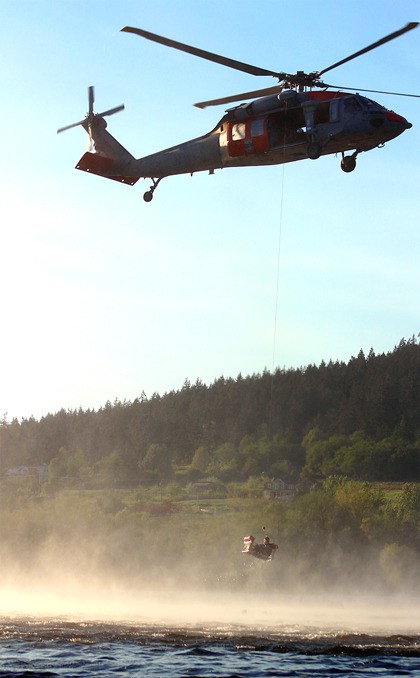In order to save you, Adam Trump has to practice throwing himself out of a helicopter.
Several times a year, Naval Air Station Whidbey Island’s Search and Rescue team performs water exercises. Their rescue swimmers leap out of one of the unit’s three MH-60S helicopters.
On Wednesday, the SAR team had an opportunity to practice those skills at Lake Campbell in warm, sunny almost summer-like conditions. They teamed up with members of North Whidbey Fire and Rescue, who kept a boat on the water as a precaution.
“Our role is if something happens, we are there to rescue the swimmers or the people in the helo,” said North Whidbey Fire and Rescue Capt. Jim O’Connor.
Wednesday, Trump stayed in the bird as a crew chief, managing the hoist that lowers rescuers up and down. He’s qualified for water and over land rescues.
“I get them in safely using the rescue device,” he said. “I have to be one step ahead of them once they’re in the water.”
And he’s also in constant, close contact with the pilots up front.
The two organizations started working together on this training exercise several years ago, O’Connor said. It’s beneficial for both groups.
They may have to work together in a rescue situation, he said. Some of the newer fire and rescue volunteers need to become accustomed to potentially working around the spray kicked up by the helo’s powerful rotor blades.
“We’ve learned what to expect and do everything we can to accommodate them,” O’Connor.
And that includes some good old-fashioned brotherly love.

The North Whidbey folks throw a barbecue and since the SAR team can’t exactly set the bird down at the county boat launch, they find another way to send food. They packed a dry bag full of hamburgers, hot dogs and the like.
A SAR rescue swimmer swam to the powerboat to retrieve and send it up to the helo.
A little more work than the McDonald’s drive-thru, but effective.
SAR operates as search and rescue platforms for EA-18G Growler as well as for other squadrons and personnel at NAS Whidbey. The base has an agreement to help the state with medical evacuations and search and rescue activities.
They can be called on to operate anywhere from Mount Hood in Oregon to the Canadian border. NAS Whidbey’s SAR team is unusual — only one of four in the country — that is trained to not just pluck distressed people from the water but to handle anything in the mountains too.


